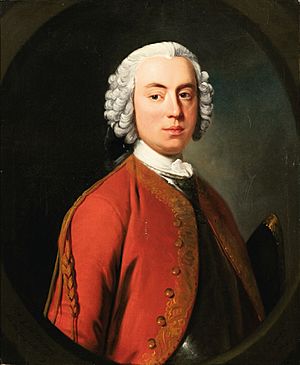Lord John Murray facts for kids
General Lord John Murray (born 14 April 1711 – died 26 May 1787) was an important British general and politician. He was known for his long military career and for caring deeply about the soldiers he commanded.
Contents
A Life of Service: Lord John Murray's Story
Lord John Murray was born on April 14, 1711. His father was John Murray, 1st Duke of Atholl. John Murray also had two half-brothers who were involved with the Jacobite movement: William Murray, Marquess of Tullibardine, and Lord George Murray.
Early Military Career
John Murray started his military career at a young age. In 1727, he became an ensign, which is a junior officer. By 1733, he was a lieutenant and captain in the 3rd Foot Guards, also known as the Scots Guards. He continued to rise through the ranks, becoming a captain-lieutenant in 1737 and a captain and lieutenant-colonel in 1738.
Leading the Black Watch
A very important part of his career began on April 25, 1745. He was made the colonel of the 42nd Regiment of Foot, famously known as the Black Watch. He led this regiment for 42 years! He served with the Black Watch in Flanders in 1747. During this time, he helped defend places like Hulst and Fort Sandberg. He also commanded the troops during a retreat to Walsoorden. In 1747, he volunteered to help defend Bergen-op-Zoom.
Caring for His Soldiers
Lord John Murray was especially known for being a true friend to his soldiers. He always looked out for the deserving officers and men in his regiment. He did a lot to support the unique character of the Black Watch, which was made up of many Highlanders.
There are stories about him marching with Highlanders who were injured at Ticonderoga in 1758. He helped them present their cases to the Chelsea board, which resulted in every injured soldier getting a pension. He even offered soldiers a cottage and garden on his own land, rent-free, if they wanted one.
Promotions and Politics
Lord John Murray continued to be promoted in the army. He became a major-general in 1755, a lieutenant-general in 1758, and a full general in 1770. He was also involved in politics. He was elected as a Member of Parliament for Perth in 1741, 1747, and 1754. He represented Perthshire in the British Parliament from 1734 to 1761.
Later Life
Lord John Murray passed away in Paris on May 26, 1787. He was 77 years old and was the oldest general in the British army at the time.
Family Life
Lord John Murray married Miss Dalton of Banner Cross Hall on September 13, 1758, in Sheffield. She was a wealthy lady from Yorkshire. They had one daughter named Mary. Mary later married Captain William Foxlowe, who became Lieutenant-general William Foxlowe. He took the name Murray in 1782.


